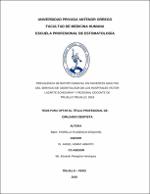Mostrar el registro sencillo del ítem
Prevalencia de biotipo gingival en pacientes adultos del servicio de odontología de los hospitales Víctor lazarte Echegaray y regional docente de Trujillo, Trujillo, 2018
| dc.contributor.advisor | Asmat Abanto, Ángel | |
| dc.contributor.author | Plasencia Esquivel, Fiorella | |
| dc.creator | Plasencia Esquivel, Fiorella | |
| dc.date.accessioned | 2018-10-03T16:46:30Z | |
| dc.date.available | 2018-10-03T16:46:30Z | |
| dc.date.issued | 2018 | |
| dc.identifier.uri | https://hdl.handle.net/20.500.12759/4364 | |
| dc.description.abstract | Determinar la prevalencia de biotipo gingival en pacientes adultos del Servicio de Odontología de los hospitales Víctor Lazarte Echegaray y Regional Docente de Trujillo. Trujillo, 2018. Material y método: El estudio prospectivo, transversal, descriptivo y observacional incluyó un total de 200 pacientes del Servicio de Odontología de los hospitales Víctor Lazarte Echegaray y Regional Docente de Trujillo, utilizando el método de selección no probabilístico: por conveniencia, a quienes se les evaluó el biotipo gingival a través del método de la transparencia de la sonda. Para determinar la confiabilidad del método, se empleó el estadístico Kappa, encontrando confiabilidades significativas de 0.762 tanto interevaluador e intraevaluador respectivamente. Se realizó un análisis de descriptivo para los resultados presentados en frecuencias absolutas y porcentuales. Resultados: La prevalencia del biotipo gingival en el sector anterior superior, fue de 115 (57.5%) para el biotipo gingival grueso, siendo este el predominante. Conclusiones: El biotipo gingival predominante fue el biotipo gingival grueso, destacando tanto en hombres como mujeres y en ambos hospitales. Asimismo, se observó que el biotipo gingival varía con la edad, el grupo etario de 40 a 50 años, presentó principalmente el biotipo gingival delgado, mientras que los grupos etarios más jóvenes de 18 a 29 y 30 a 39 años presentaron mayormente el biotipo gingival grueso. | es_PE |
| dc.description.abstract | To determine the prevalence of gingival biotype in adult patients of the Dental Service of hospitals Víctor Lazarte Echegaray and Regional Docente of Trujillo. Trujillo, 2018. Material and methods: The prospective, cross-sectional, descriptive and observational study, included a total of 200 patients of the Dental Service of hospitals Victor Lazarte Echegaray and Regional Docente de Trujillo, using the non-probabilistic selection method: for convenience, to whom the gingival biotype was evaluated through the method of transparency of the probe. To determine the reliability of the method, the Kappa statistic was used, finding significant reliabilities of 0.763, both inter-rater and intra-rater, respectively. A descriptive analysis was performed for the results presented in absolute and percentage frequencies. Results: The prevalence of the gingival biotype in the upper anterior sector was 115 (57.5%) for the thick gingival biotype, this being the predominant one. Conclusions: The predominant gingival biotype was the thick gingival biotype, standing out both in men and women and in both hospitals. Likewise, it was observed that the gingival biotype varies with age, the age group of 40 to 50 years, presented mainly the thin gingival biotype, while the youngest age groups of 18 to 29 and 30 to 39 years presented mostly the thick gingival biotype. | en_US |
| dc.description.uri | Tesis | es_PE |
| dc.format | application/pdf | es_PE |
| dc.language.iso | spa | es_PE |
| dc.publisher | Universidad Privada Antenor Orrego - UPAO | es_PE |
| dc.relation.ispartofseries | T_ESTO_523 | |
| dc.rights | info:eu-repo/semantics/openAccess | es_PE |
| dc.source | Universidad Privada Antenor Orrego - UPAO | es_PE |
| dc.source | Repositorio institucional - UPAO | es_PE |
| dc.subject | Prevalencia | es_PE |
| dc.subject | Biotipo | es_PE |
| dc.title | Prevalencia de biotipo gingival en pacientes adultos del servicio de odontología de los hospitales Víctor lazarte Echegaray y regional docente de Trujillo, Trujillo, 2018 | es_PE |
| dc.type | info:eu-repo/semantics/bachelorThesis | es_PE |
| thesis.degree.level | Licenciatura | es_PE |
| thesis.degree.grantor | Universidad Privada Antenor Orrego. Facultad de Medicina Humana | es_PE |
| thesis.degree.name | Cirujano Dentista | es_PE |
| thesis.degree.discipline | Estomatología | es_PE |
Ficheros en el ítem
Este ítem aparece en la(s) siguiente(s) colección(es)
-
Estomatología [567]

